Ain't no drama like deposed royal drama
Also: Napier's bones, a horse-handled dagger and Nancy Astor's tiara
Hi guys, sorry it’s been an age — I’ve had multiple posts in the works but then got derailed due to my agonies, lol. Eh, there were reasons but who tf cares. Let’s get right to it, shall we?
I have to show you this incredible 17th century jade-hilted Mughal dagger that I had originally highlighted in one of my discarded posts. It was included in Splendour: The Philippe Missillier Collection of Islamic & Indian Arms and Armour at Sotheby’s London on April 29th, and I recommend having a look through the whole auction because it’s super interesting and some of the pieces are absolutely stunning.
There are other carved horse-hilted daggers in the auction, but Sotheby’s says this particular one is extremely rare because the hilt — which is carved from a single piece of pale green jade — also features the heads of four other animals, two rams and two lions. The eyes of the horse are inlaid with gold and set with black-and-white banded onyx, while the additional animals feature ruby eyes set in gold.
Here’s a close-up:
The curved blade is made of double-edged watered steel, with a central ridge and a chiseled arabesque decoration that’s overlaid with gold at the forte, or the strongest part of the blade.
The piece was estimated at £50,000 - £80,000 ($38,000 - $60,000) but sold for £444,500 ($334,000), which just shows that my eye for this stuff is never going to align with my bank account.
Heads up, Sotheby’s has decided to rename their Magnificent Jewels auctions. Here’s the explanation:
As the global leader in luxury auctions, Sotheby’s continually responds to the changing profiles and behaviors of the modern collector. To this end, our legendary Magnificent Jewels auctions have been renamed ‘High Jewelry,’ a title that aligns more closely with today’s increasingly digital marketplace. This change raises our online visibility, furthering our reach to new audiences and confirming our commitment to outstanding results."
Does it? Swell.
So anyway, their HIGH JEWELRY sale in Geneva was last Tuesday, and the blockbuster lot was the Mediterranean Blue, a big ol’ 10.03-carat Fancy Vivid blue diamond. You guys know I’m usually all *fart noise* about diamonds, but I must admit I’m very partial to a blue. They’re really fricking pretty, plus they’re cool — I told you guys a while back about how they come from far deeper in the earth than other diamonds, thanks to boron (the element that gives them their color) piggybacking into the depths of the earth’s mantle on a shifting oceanic plate billions of years ago.
Blue diamonds are also tough to cut. The crystals are usually asymmetrical and the color sometimes isn’t evenly distributed throughout the rough, so it takes very careful study and cutting to bring out the best in the stone. As a result, they’re often seen in slightly tweaked versions of traditional cuts. In this case, the Mediterranean Blue is a “cushion modified brilliant-cut,” which means it’s a brilliant cut — which is usually round — that’s been modified into a cushion cut, which has a more rectangular outline with softly rounded edges.
Sotheby’s says the cutting process alone took six months, following a full year of study of the original 31.93 carat rough stone. It was mined in 2023 from South Africa’s famous Cullinan Mine (formerly known as the Premier Mine), which is the source of some of the world’s most extraordinary blue diamonds.
The stone was estimated to sell for $20 million, and the bidding opened with a bid of 9 million Swiss francs. I watched the livestream as the offers ping-ponged between two phone bidders, and the battle went on for around three minutes until one of them — according to National Jeweler, it was an American private collector — finally won out with a bid of 15 million Swiss francs. The buyer’s premium and other fees bumped the final price to 17.9 million Swiss francs, or $21.5 million.
Christie’s is still using the “Magnificent Jewels” handle — gosh, how passé — and they held their big Geneva sale last Wednesday. The official title was Magnificent Jewels Including A Bouquet of Gems: A Superb Collection of Jewels by JAR, and as you can probably guess, it included a 21-piece private collection of jewelry created by Joel Arthur Rosenthal, a.k.a. JAR. (I’ve talked about the reclusive designer in the past, so if you missed it, go here to read up on his background!)
Two of the JAR pieces stood out to me as excellent representations of his work. The chain necklace above showcases his love of color — featuring a setting of 18k rose gold and blackened silver, the piece is a color wheel of gemstones, including round brown diamonds, emeralds, tourmalines, tsavorite and spessartine garnets, peridots, purple, orange and pink sapphires, topazes, fire opals, rubies, pink and purple spinels, amethysts, and aquamarines. I know it looks a bit gaudy laid out like that, but do click through to see it on a model. It’s really pretty.
The other piece I want to point out highlights JAR’s mastery of sculptural jewelry. His “Apricot Blossom” bangle features flowers with diamond-set petals and reddish orange and yellow enamel stamens, supported by a branch made of blackened silver and yellow gold.
The photo doesn’t do it justice, so please click here to watch a video charmingly narrated by François Curiel, Chairman of Christie’s EMEA (Europe, Middle East and Africa). Curiel presents a short background on JAR’s life — although I’d happily listen to him talk for hours on any topic — but most importantly we get to see video of the bangle, with closeups that allow us to compare the workmanship of the rough bark-like texture of the apricot branch with the exquisite pavé gem-setting technique that JAR is known for.
The bangle was estimated to sell for up to 550,000 Swiss francs ($650,000), but it left that number in the dust, reaching 2.4 million Swiss francs, or $2.8 million.
I love this piece. It’s nothing religious — in fact, it’s a mid-19th century bangle commemorating a champion British thoroughbred racehorse called Lord Clifden (1860-1875), who won a number of big races in the 1860s. The bangle is made of gold, with old-cut diamond-set letters spelling out LORD CLIFDEN within a central band of brown guilloché enamel. It was included in the Knightsbridge Jewels sale at Bonhams London yesterday, but it didn’t sell — probably because it’s missing a bunch of diamonds. Or because it’s a bracelet dedicated to a Victorian horse. Or because I’m poor.
Lord Clifden was a bay colt who was purchased by Carnegie Robert Jervis, the 3rd Viscount St Vincent (1825-1879) in 1863. The horse often won despite being prone to bad starts, as is documented in this 1863 account of the St. Leger Stakes in Doncaster, England, in which he came from three lengths behind to win “in the most gallant style” by a half a length. That race made the Viscount quite a bit of money, and it doesn’t look like we have a precise date as to when the bangle was made, but it was most likely commissioned around this time as Jervis eventually sold Lord Clifden in 1870. The bangle subsequently passed down through the family, all the way to Edward Jervis, the 8th Viscount St Vincent (1951-2023).
One final note: After Lord Clifden retired from racing, Bonhams says he became champion sire of Great Britain and Ireland in 1876, and “his sire line survives today through thoroughbred Bay Ronald and his son Dark Ronald.” DARK RONALD.
This intriguing little silver object is actually a set of “Napier’s bones,” which, according to Sotheby’s, is:
“an arithmetical device for multiplication, division and extracting square roots. It was created following the publication of Mirifici Logarithmorum Canonis Descriptio in 1614 by the Scottish mathematician, physicist and astronomer John Napier (1550-1617), 8th Laird of Merchiston.”
I’ve never heard of it before, so Wikipedia told me (just before the math fear set in and I peaced out) that those little rods with the engraved figures help to quickly multiply and divide numbers by using addition and subtraction.
This set dates to around 1670 and it’s a miracle that it’s intact, given that each of those little rods can be removed depending on which one(s) you need for your calculations. As for the decoration, let’s go back to Sotheby’s:
The cover of the case is engraved with the arms of St. John impaling Cavendish for Oliver St. John, 2nd Earl of Bolingbroke (before 1634 - 1688), who in 1654 married Frances (d. 1678), daughter of William Cavendish, Duke of Newcastle-upon-Tyne (1593-1676).
“Impaling” is a violent word, but in heraldry it simply means that two coats of arms have been combined in one shield to indicate a union, and — as in this case — the union depicted was often marital.
The piece has a detailed provenance, and it’s well documented as having passed through generation after generation of the aristocratic Montagu family until 1832, when the Hon. Lucy Elizabeth Montagu-Scott married Cospatrick Alexander Douglas-Home, the 11th Earl of Home. From that point on it descended to the present day in the collection of the Earls of Home at their estate in the Scottish Borders.
It’s included in today’s Noble & Private Collections including Property from the Earl of Home auction at Sotheby’s London and is estimated at £5,000 - £7,000, or $3700 - $5,200.
This lovely piece is known as the Astor Turquoise and Diamond Tiara. In 1929, Cartier purchased the platinum and diamond bandeau at the center of the tiara from a client, listing it in their records as a “head ornament, 3 large round diamonds in the centre, in Boucheron case.”
At this moment in time, the world was still reeling from the 1922 discovery of the tomb of King Tutankhamun, and Eastern design motifs were heavily influencing the decorative arts of the West. Cartier were well known for incorporating Egyptian, Mughal and Persian styles in their jewelry — particularly via the use of carved gemstones — and that’s how this very pretty but fairly tame tiara got zhuzhed up with a series of Mughal-inspired carved turquoise leaves and fans.
The additions were made by the craftsmen of English Art Works, Cartier’s London workshop. Once the piece was finished, it was displayed in a 1930 charity event organized by the National Jewellers' Association called the “Pageant of Living Jewels” at the Jewels of Empire Ball held at the extremely Art Deco Park Lane Hotel in London. According to the lot notes, as many as 60 society ladies were presented as “living jewels,” wearing precious gems pillaged — sorry, “sourced” — from across the British Empire:
There were five representations of each gem. A few of the Empire Ball’s “living jewels” are recorded as Muriel Ashley (emerald), Barbara Cartland – then Mrs McCorquodale (jade), Mrs C. A. Cartwright (jet), Lady Diana Cooper (diamond), Rosita Forbes (ruby), the actress Gertrude Lawrence (black pearls), Mrs Claude Leigh (gold), Gwen Mond (jade) and Lady Mary Strickland (sapphire). Margaret Whigham, then ‘Deb of the Year’ and later the infamous Duchess of Argyll, wrote, “Bridget (Poulett – favourite of Cecil Beaton) and I were told to wear coral and turquoise respectively – not diamonds and emeralds as we had hoped”.
Waldorf Astor, the 2nd Viscount Astor (1879-1952) purchased the tiara for his wife Nancy shortly after the ball. I’m out of space, so click through to see her wearing it in a photo alongside Charlie Chaplin, George Bernard Shaw and her husband at the 1931 premiere of City Lights at the Dominion Theatre in London. What an extraordinary piece of ephemera.
The tiara is included in the Bonhams London Jewels sale on June 5th and is estimated at £250,000 - £350,000, or $330,000 - $470,000.
OMG, you guys: remember when I was all jazzed a little while back that an El Greco painting of St. Sebastian was going up for auction? Holy crap. Christie’s literally wound up yanking the painting the day before the auction because the Romanian government contested the sale and stated their intent to have the piece legally repatriated to Romania. Christie’s gave them a month and battle lines were DRAWN, y’all.
So apparently, the painting was originally in the collection of the Romanian Royal Crown and details are pretty murky, but it’s believed that King Michael of Romania sold it to the Wildenstein & Co. Gallery in New York in 1976. And now King Michael’s nephew Prince Paul of Romania has surfaced and is ALSO trying to stake a claim. (I should mention that 76yo Paul was a fugitive — trying to avoid a jail sentence in Romania over some sort of illegal land deal — until just last month, when he was arrested in France.)
Prince Paul says that King Michael (who died in 2017) was a Nazi/Soviet/whatever “puppet” who stole two boxcars-worth of Romanian royal treasure (including the El Greco) in the 1940s and hid it for decades in a Swiss bank until both his parents had finally passed away.
(I cannot express to you just how much this brand of batshit royal outrage makes me want to yodel with joy.)
Paul is the grandson of Michael’s father, King Carol II. He’s claiming that the Romanian government has no right to the painting because Carol II was its sole owner, and so he wants Christie’s to give it to him for free — lololololololol good luck with that. You can read about the whole sordid thing in the bastion of class that is the New York Post. (At one point the article mentions the Nazis still being in power in 1947. Who needs fact checkers? We have AI now!)
The sale has now been blocked until the end of June. I’d put my money on Christie’s, but we’ll see. Hopefully it’ll get pushed back even farther so Paulie has more time to escape back to Malta or wherever.
Ok that’s it. Hope you’re all well — and if you’re in the US, enjoy the long weekend. Hopefully the rain will stop for five minutes so I can go outside and mess around with some plants. Also, I promise not to be so long with the next installment — the High Magnificent Jewelsry auctions in New York are coming up next month, so I’ll be sure to update you with my always invaluable commentary.
Love you guys! Bye, M x


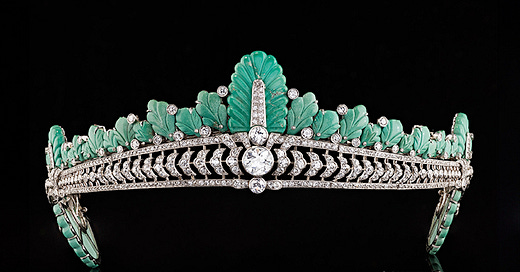

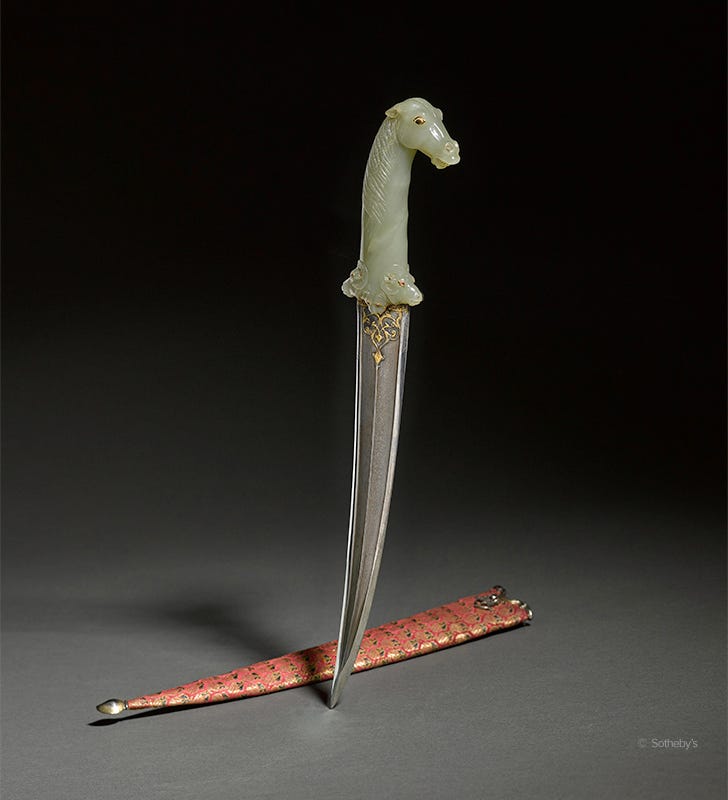
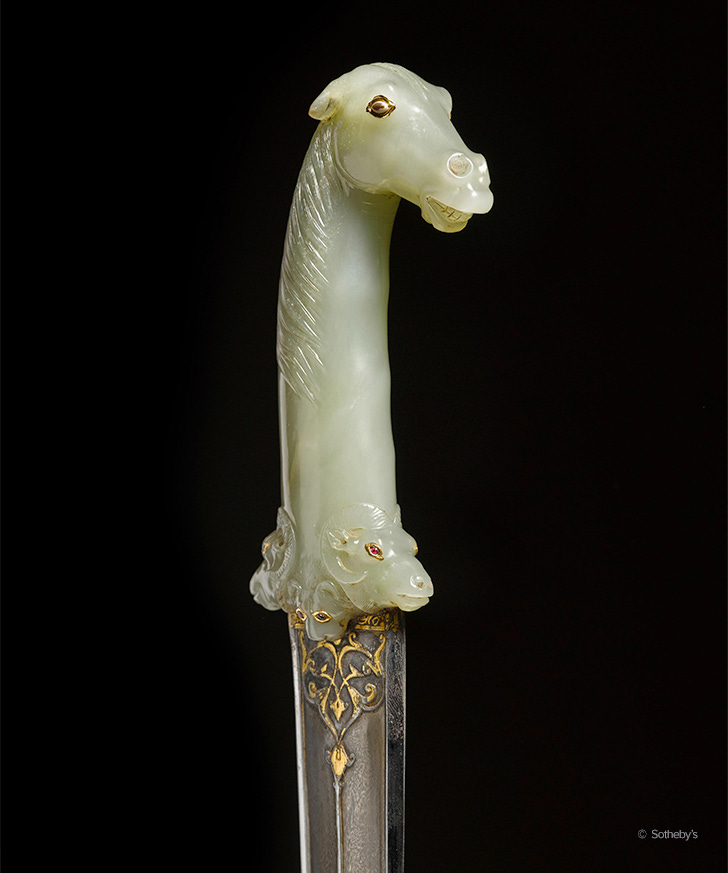

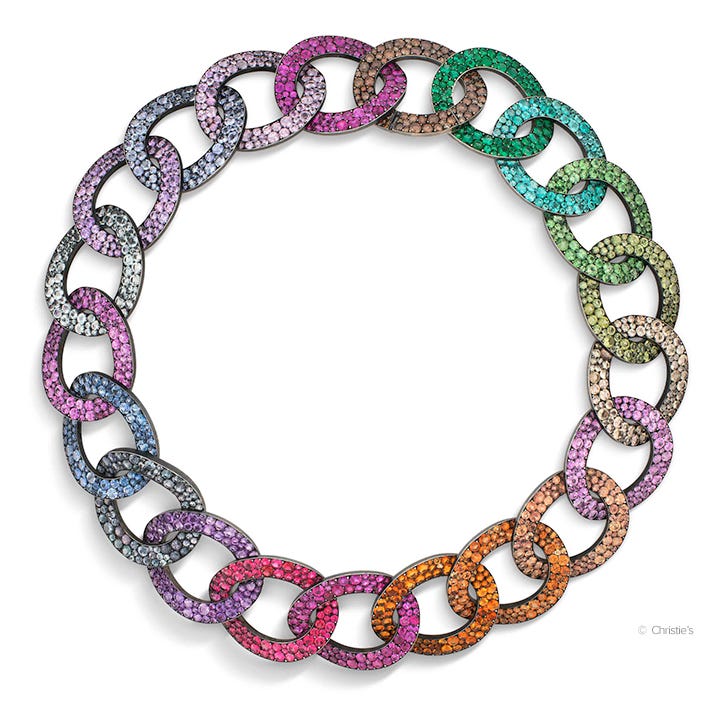
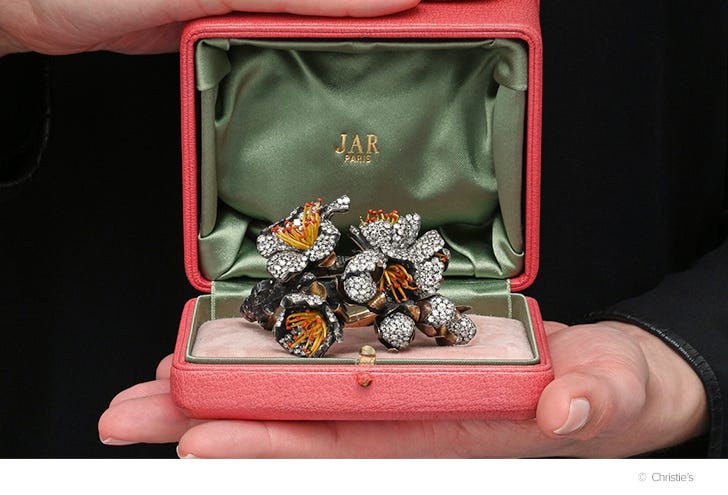
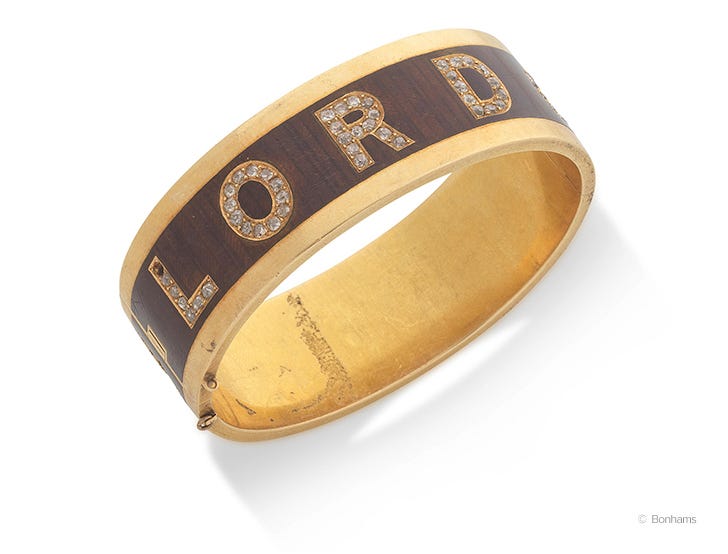
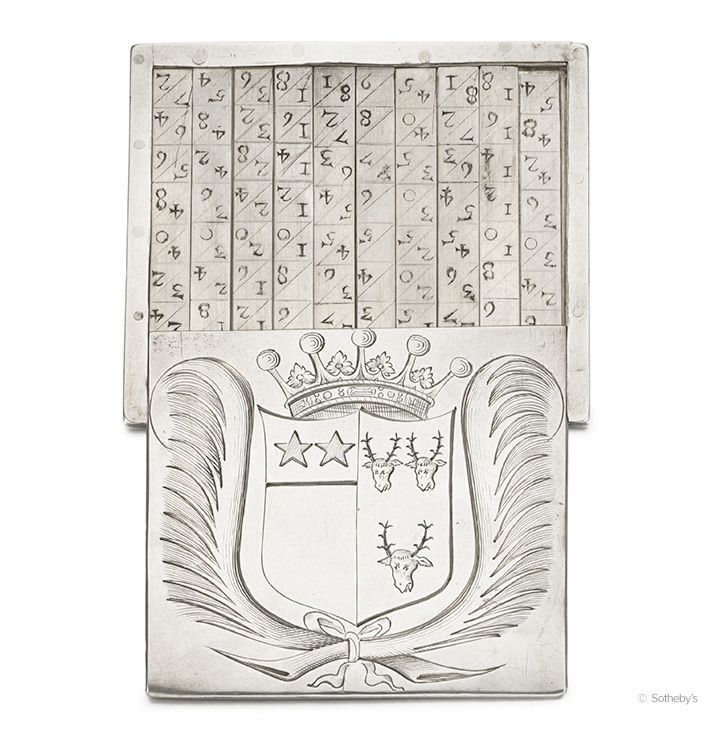
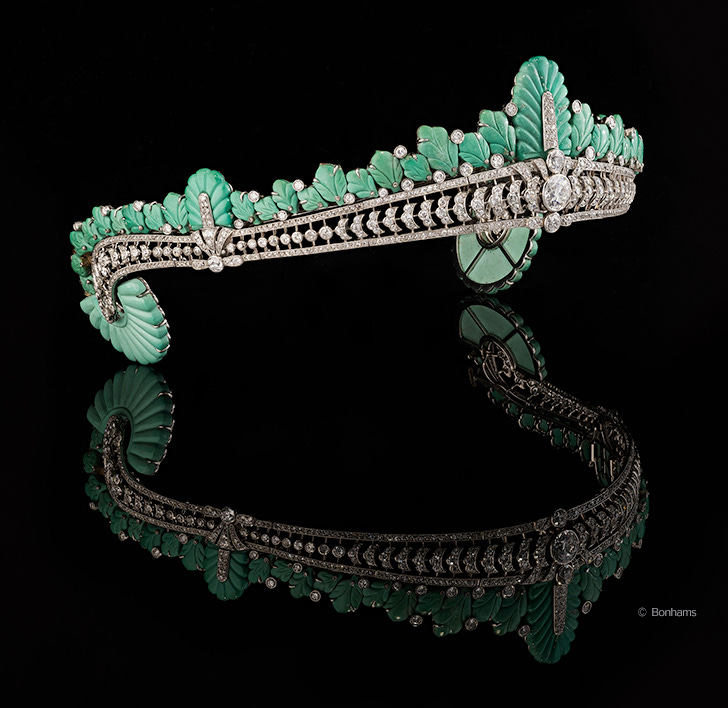
sorry these are no longer my magnificent stickers, these are my high stickers
Happy to see this gorgeousness with all the odd origin stories back in my inbox.